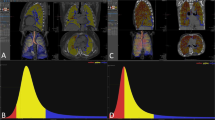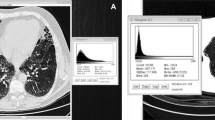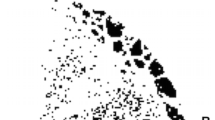Abstract
Purpose
The aim of this study was to assess the accuracy of some computed tomography (CT) quantitative indices (histogram features, ranges of density and one novel volumetric index) in the discrimination between normals and patients affected by lung fibrosis, and to compare their morphologic-functional relationship with the visual score one.
Materials and methods
We analysed thin-section CTs and pulmonary function tests (PFTs) of six healthy subjects and 31 patients affected by lung fibrosis, including 17 with a usual interstitial pneumonia pattern (UIP group), and 14 with a predominant pattern of ground-glass opacities without honeycombing (non-UIP group). Presence and extent of various CT findings were assessed by the visual score as well as by CT computer indices.
Results
Together with the histogram features, fibrosis ratio (defined as the ratio of nonfibrotic CT lung volume divided by total CT lung volume) contributed to objectively differentiate fibrotic lungs from normal lungs. The range of density 700 to 400 HU showed the greatest degree of correlation with physiologic abnormality in the non-UIP group. In the UIP group, the lone visual score provided prediction of functional impairment.
Conclusions
The visual score is still the main radiological method of quantifying the extent of abnormalities in patients with UIP, whilst the range of density 700 to 400 HU can be helpfully applied in a predominant pattern of ground-glass and reticular opacities without honeycombing.
Riassunto
Obiettivo
Valutare l’accuratezza di alcuni indici quantitativi utilizzati in tomografia computerizzata (TC) (istogrammi, intervalli di densità ed indici volumetrici) nel discriminare pazienti normali da pazienti affetti da fibrosi polmonare e confrontare la loro relazione morfologica-funzionale con lo score visivo.
Materiali e methodi
Abbiamo analizzato scansioni TC a strato sottile di sei soggetti sani e di 31 pazienti con fibrosi polmonare, compresi 17 con un pattern di polmonite interstiziale usuale (gruppo di UIP) e 14 con un pattern predominante di ground-glass senza honey-combing (gruppo non-UIP). La presenza e l’estensione dei vari reperti TC sono stati valutati sia con score visivo che con indici TC quantitativi.
Risultati
Insieme agli istogrammi, l’indice fibrotico volumetrico (definito come il rapporto tra il volume di polmone non fibrotico e il volume polmonare totale) ha contributio nel differenziare in modo obiettivo i polmoni fibrotici dai polmoni normali. Il range di densità −700–400 HU ha mostrato la maggiore correlazione con i parametri funzionali nel gruppo dei pazienti non-UIP. Nel gruppo UIP, solo lo score visivo ha fornito una corretta previsione del danno funzionale.
Conclusioni
Lo score visivo è ancora il metodo radiologico principale per quantificare l’estensione della patologia in pazienti con UIP, mentre l’intervallo di densità −700–400 HU può essere vantaggiosamente applicato in un pattern predominante a ground-glass e reticolare senza honey-combing.
Similar content being viewed by others
References/Bibliografia
Hansell DM, Milne DG, Wilsher ML, Wells AU (1998) Pulmonary sarcoidosis: morphologic associations of airflow obstruction at thin section CT. Radiology 209:697–704
Hansell DM, Wells AU, Padley SP, Muller NL (1996) Hypersensitivity pneumonitis: correlation of individual CT patterns with functional abnormalities. Radiology 199:123–128
Wells AU, King AD, Rubens MB et al (1997) Lone cryptogenic fibrosing alveolitis: a functional-morphologic correlation based on the extent of disease on thin-section computed tomography. Am J Respir Crit Care Med 155:1367–1375
Zompatori M, Calabrò E, Chetta G et al (2003) Chronic hypersensivity pneumonitis or idiopathic pulmonary fibrosis? Diagnostic role of high resolution computed tomography (HRCT). Radiol Med 106:135–146
King TE, Tooze JA, Schwarz MI et al (2001) Predicting survival in idiopathic pulmonary fibrosis: scoring system and survival model. Am J Respir Crit Care Med 164:1171–1181
Cherniack RM, Colby TV, Flint A et al (1995) Correlation of structure and function in idiopathic pulmonary fibrosis. Am J Respir Crit Care Med 151:1180–1188
Wells AU, Desai SR, Rubens MB et al (2003) Idiopathic pulmonary fibrosis: a composite physiologic index derived from disease extent observed by computed tomography. Am J Respir Crit Care Med 167:962–969
Staples CA, Muller NL, Vedal S et al (1987) Usual interstitial pneumonia: correlation of CT with clinical, functional and radiologic findings. Radiology 162:377–381
Xaubet A, Agusti C, Luburich P et al (1998) Pulmonary function tests and CT scan in the management of idiopathic pulmonary fibrosis. Am J Respir Crit Care Med 158:431–436
Uppaluri R, McLennan G, Enright P et al (1998) Adaptive Multiple Feature Method (AMFM) for the early detection of parenchymal pathology in smoking population. SPIE Med Imaging Physiol Function 3337:8–13
Delorme S, Keller-Reichenbecher MA, Zuna I et al (1997) Usual interstitial pneumonia. Quantitative assessment of high-resolution computed tomography findings by computer assisted texture based image analysis. Invest Radiol 32:566–574
Uppaluri R, Hoffman EA, Sonka M et al (1999) Interstitial lung disease: a quantitative study using the adaptive multiple feature method. Am J Respir Crit Care Med 159:519–525
Heitmann KR, Kauczor HU, Mildenberger P et al (1997) Automatic detection of ground glass opacities on lung HRCT using multiple neural networks. Eur Radiol 7:1463–1472
Rodriguez LH, Vargas PF, Raff U et al (1995) Automated discrimination and quantification of idiophatic pulmonary fibrosis from normal lung parenchyma using generalized fractal dimensions in high-resolution computed tomography images. Acad Radiol 2:10–18
American Thoracic Society, European Respiratory Society (2002) American Thoracic Society/European Respiratory Society International Multidisciplinary Consensus Classification of the Idiopathic Interstitial Pneumonias: this joint statement of the American Thoracic Society (ATS), and the European Respiratory Society (ERS) was adopted by the ATS board of directors, June 2001 and by the ERS executive committee, June 2001. Am J Respir Crit Care Med 165:277–304
Adams H, Bernard MS, McConnochie K (1991) An appraisal of CT pulmonary density mapping in normal subjects. Clin Radiol 43:238–242
Best AC, Lynch AM, Bozic CM et al (2003) Quantitative CT indexes in idiopathic pulmonary fibrosis: relationship with physiologic impairment. Radiology 228:407–414
Lynch DA, Gamsu G (1998) Imaging of diffuse parenchymal lung diseases. In: Schwarz MI, King TE (eds) Interstitial lung disease. 3rd ed. Hamilton, Ontario, pp 95–96
Uppaluri R, Mitsa T, Sonka M et al (1997) Quantification of pulmonary emphysema from lung computed tomography images. Am J Respir Crit Care Med 156:248–254
Hartley PG, Galvin JR, Hunningake GW et al (1994) High resolution CT-derived measures of lung density are valid indexes of interstitial lung disease. J Appl Physiol 76:271–277
Do KH, Lee JS, Colby TV et al (2005) Nonspecific interstitial pneumonia versus usual interstitial pneumonia: differences in the density histogram of high-resolution CT. J Comput Assist Tomogr 29:544–548
Wu MT, Chang JM, Chiang AA et al (1994) Use of quantitative CT to predict postoperative lung function in patients with lung cancer. Radiology 191:257–262
Rienmuller RK, Behr J, Kalender WA et al (1991) Standardized quantitative high resolution CT in lung diseases. J Comput Assist Tomogr 15:742–749
Kauczor HU, Heitmann K, Heussel CP et al (2000) Automatic detection and quantification of ground-glass opacities on high-resolution CT using multiple neural networks: comparison with a density mask. AJR Am J Roentgenol 175:1329–1334
Wu MT, Pan HB, Chiang AA et al (2002) Prediction of postoperative lung function in patients with lung cancer: comparison of quantitative CT with perfusion scintigraphy. AJR Am J Roentgenol 178:667–672
Hansell DM (2001) Computed tomography of diffuse lung disease: functional correlates. Eur Radiol 11:1666–1680
Strickland NH, Hughes JM, Hart DA et al (1993) Cause of regional ventilation-perfusion mismatching in patients with idiopathic pulmonary fibrosis: a combined CT and scintigraphic study. AJR Am J Roentgenol 161:719–725
Mino M, Noma S, Kobashi Y, Iwata T (1995) Serial changes of cystic air spaces in fibrosing alveolitis: a CT-pathological study. Clin Radiol 50:357–363
Battista G, Sassi C, Zompatori M et al (2003) Ground-glass opacity: interpretation of high resolution CT findings. Radiol Med 106:425–444
Gurney JW, Habbe TG, Hicklin J (1997) Distribution of disease in cystic fibrosis: correlation with pulmonary function. Chest 112:357–362
Author information
Authors and Affiliations
Corresponding author
Rights and permissions
About this article
Cite this article
Sverzellati, N., Calabrò, E., Chetta, A. et al. Visual score and quantitative CT indices in pulmonary fibrosis: Relationship with physiologic impairment. Radiol med 112, 1160–1172 (2007). https://doi.org/10.1007/s11547-007-0213-x
Received:
Accepted:
Published:
Issue Date:
DOI: https://doi.org/10.1007/s11547-007-0213-x




